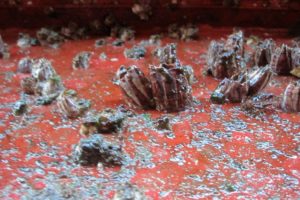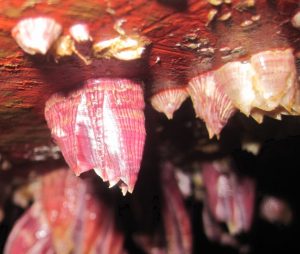Ships contribute to aquatic biological invasions through the transport of non-indigenous aquatic species. Aquatic invasive species negatively affect native species due to direct interactions, such as predation and competition. Many aquatic invasive species are transferred either in ship ballast water or on ship submerged hull surfaces, especially to niche areas. Biofouling is the attachment of organisms to vessel’s submerged surfaces and is recognized as a major mechanism through which invasive aquatic species could be spread.
Antifouling coating systems are commonly used to protect submerged surfaces and to prevent the accumulation of biofouling. The International Convention on the Control of Harmful Anti-fouling Systems on Ships was adopted on 5 October 2001. The AFS Convention prohibited the use of harmful organotin compounds in anti-fouling paints used on ships. Additional, AFS Convention established a mechanism to prevent the potential future use of other harmful substances in anti-fouling systems. The Convention entered into force on 17 September 2008. 
At its seventy-first session in July 2017, MEPC approved a new output to amend Annex 1 to the AFS Convention to include controls on cybutryne. The IMO has prohibited the use of cybutryne in antifouling systems (AFS) from 1 January 2023, as studies have proven that the substance is harmful to a variety of marine organisms.
An important step to protect marine ecosystems from the negative effects of invasive species is the GloFouling Partnerships project, as part of the wider efforts by the International Maritime Organization (IMO), in collaboration with the United Nations Development Programme (UNDP) and the Global Environment Facility (GEF).
The state of California has already implemented stricter local regulations related to Biofouling Management. From 1 January 2018, is required a vessel-specific Biofouling Management Plan and Record Book consistent with the requirements of the IMO Biofouling Guidelines that should be kept on-board and the vessel’s submerged hull surfaces should be managed in accordance with the Biofouling Management plan.
The New Zealand has already implemented stricter local regulations related to Biofouling Management. From 15 May 2018, vessels must arrive in New Zealand with ‘clean hulls’. More specific, one of the following measures must be applied to meet the ‘Clean Hull’ requirement:
– Cleaning before visit to New Zealand, (or immediately on arrival in a facility or by a system, approved by MPI). All biofouling must be removed from all parts of the hull and this must be carried out less than 30 days before arrival to New Zealand or within 24 hours after time of arrival
-Continual Maintenance using best practice, including: application of appropriate antifouling coatings, operation of marine growth prevention systems on sea-chests and in-water inspections with biofouling removal as required
-Application of Approved Treatments. Treatments are approved and listed under the Approved Biosecurity Treatments MPI-STD- ABTRT.
The Australia has already implemented stricter local regulations related to Biofouling Management. The Biosecurity Amendment (Biofouling Management) Regulations 2021 (biofouling regulations) will enter into force on 15 June 2022. This regulation requires operators of all vessels to provide information on biofouling management practices prior ship’s arrival in Australia. Vessel operators can demonstrate proactive management of biofouling by implementing one of the 03 accepted proactive biofouling management options: 
-Implementation of an effective biofouling management plan
-Cleaned all biofouling within 30 days prior to arriving in Australian territory
-Implementation of an alternative biofouling management method pre-approved by the department.
The 1st version of the Systemantis Biofouling Management Plan has been developed to assist shipping companies to comply with the latest IMO and other local regulatory biofouling requirements, with respect to your company’s Environmental Policy.
A cornerstone to our Biofouling Management Plan is our operational/maintenance best practices for ship areas Susceptible to Biofouling in order to maintain vessel free from biofouling, as reasonably practicable, complying with applicable international and local regulations.
Source: systemantis.com, www.imo.org, www.slc.ca.gov,www.mpi.govt.nz, www.agriculture.gov.au
Contact us to receive an offer for our Biofouling Management Plan
